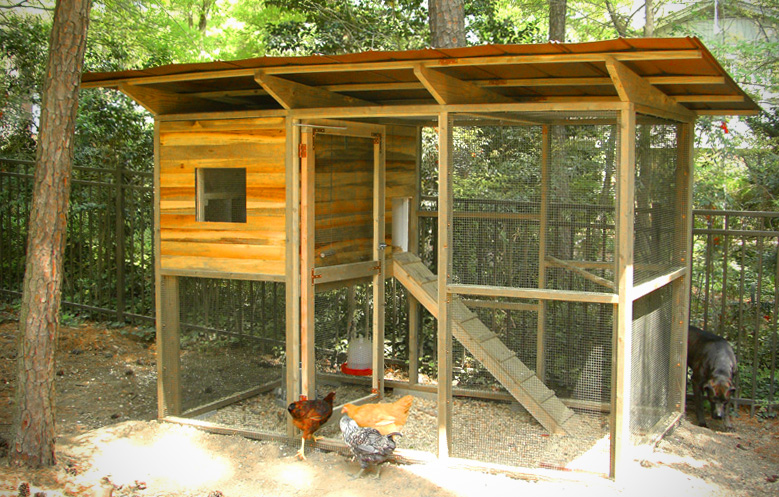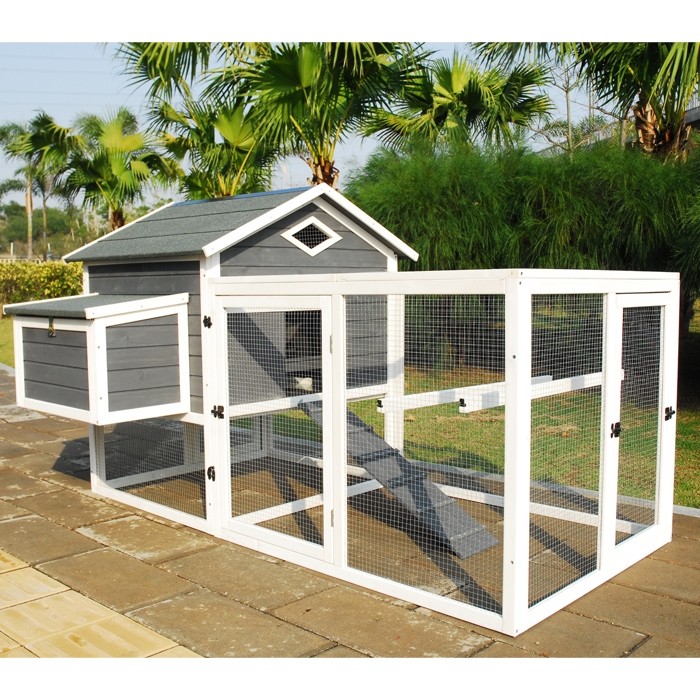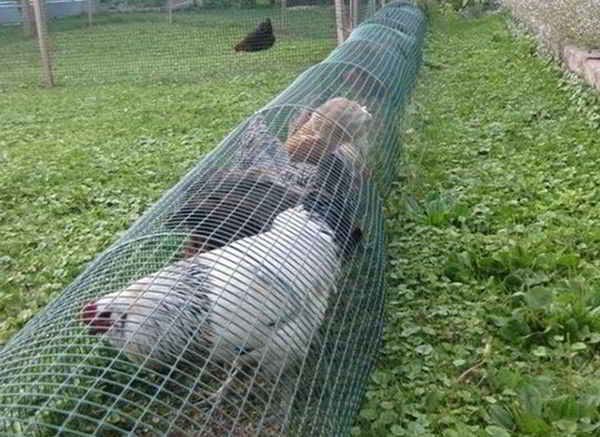Attention: Sometimes we receive a commission when you make a purchase through the links on our site.
A common question I have heard people ask is “Does a chicken run need a roof?” Maybe you have wondered that yourself. You have probably seen a lot of chicken runs with a roof and then also the many without. So what gives?
In almost all scenarios, yes, a chicken run does need a roof. The only way to ensure you are doing everything you can to protect your backyard chicken flock is to have a properly secured area for them. Having a roof on your chicken run is one of the best ways of protecting them. You can choose to forego a roof or covering on a chicken run, but you are taking chances and risks.

In our last house, we did not have a covered chicken run and it worked great for the awhile. We had a large chicken coop so there was plenty of room inside for roosting and laying. It also had a brooder box for when we added new chicks. We made a waterer out of a five gallon bucket and hung that from the rafters and used multiple feeders since we had a decent sized flock. The chickens free ranged and could roam the entire fenced backyard. Eventually, we lost our entire flock to a predator. If the coop would have been contained within a fenced chicken run with a roof, we could have avoided losing our whole flock.
So why have a roof on a chicken run, how do you make it, and what else should I consider when putting together a chicken run?
Three Reasons Why Your Chicken Run Needs A Roof
To Keep Your Chickens In
Have you ever had to chase down and catch a chicken that is loose? Let me tell you, it is not very fun! Now times that by four or eight or even more. Pro Tip: If your chickens do get out, it is probably easiest to wait until sunset and let them make their own way back to the coop to roost. That is unless there is a risk that they run out onto a road or there is something else that is dangerous for them. Having a roof on your chicken run, especially if it is shorter, will keep your flock from flying out at their leisure. Most likely, with a six or eight foot tall chicken run, they will stay in on their own. But once one finds a way out, it does not take long for the others to figure it out as well.
To Keep Predators Out
There are many predators that want to eat your chickens for dinner, to put it bluntly. Coyotes, racoons, and hawks just to name a few. It is also not uncommon for dogs to eat chickens as well. Do you know what predators are in your area? Ask around to your neighbors. County extension offices are a great resource for things like this as well. A simple Google search can easily get your their contact information. Having a roof on your chicken run will help keep larger birds such as hawks and owls from swooping down into the chicken run from above. It will also keep predators, like racoons, from climbing into your chicken run from the ground.
To Provide Protection From The Elements
How much rain and snow do you get? What is the floor inside of your chicken run? Having a roof that is sloped will help keep the floor of your chicken coop nice and dry. Obviously, with sides that are open, it won’t keep out every drop of rain or melted snow. But it will keep most of it out. That way your happy backyard flock won’t be walking around in mud everytime there is a storm. Depending on the placement of your coop and the angle that the sun hits your chicken run, you might want to consider not putting a solid roof over part of your chicken run. This would be true if most of your sunlight comes from straight overhead. It would allow more direct sunlight in to help dry up muddy ground. Also, sunlight is important for your hen’s health and egg production.

Source: Petbarn
Type Of Materials For A Chicken Run Roof
Chicken Wire
This is probably the easiest, least expensive option when it comes to a roof for your chicken run. You can simply unroll chicken wire, cut it to length, and staple it to the side posts of your chicken run. This option won’t provide any protection from the elements, but it will keep predators out and your chickens in. So two out of three of the reasons above. If you need something fairly quick to provide protection, this is a good option.
Corrugated Metal Roofing Sheets
I have had good luck with metal roofing. At our last house, we were left with several sheets of metal roofing, which came in handy. I have seen scraps and odds and ends of metal roofing on Craigslist several times. You can even check second hand building material stores as well. Luckily you don’t need long pieces. To use these sheets most effectively, you will need to make one side of your chicken run higher than the other. This allows the water to run off the roof. It does not need to be a whole lot, only an inch or two. Obviously, you can make it higher to match modern or contemporary houses. Or a traditional gable roof with the ridge running through the middle. You can match the design of your chicken coop or even your house. But corrugated metal roofing sheets are long lasting, very durable roofing material.
Plastic Roofing Sheets
You can buy roofing sheets that are plastic that look almost identical to metal roofing sheets. I do see some advantages with these versus the metal sheets. In my opinion, I would rather cut plastic versus metal. That will vary depending on the tools you have on hand and your experience. I’ve worked with metal and it is not uncommon for me to have jagged edges or sliced fingers. But that could just be me. Anyway…In the plastic sheets, you can get them in a clear or translucent sheet, kinda like you might have seen on some greenhouses. So that would help allow a little more light in if you needed that. Also, rain hitting a metal roof can be a bit loud for some. So having the plastic sheeting would dampen that a little. In the negative column, I don’t see the plastic sheets being as durable as the metal ones. Also, they are not as commonly used, at least around here. So it might be harder to find a deal on pricing.
Asphalt or Cedar Shake Shingles
This is my favorite option out of the four. I like it best because I think it looks the best and that is obviously very subjective. To do asphalt or cedar shake shingles, you are going to need a bit stronger framing and roofing. Simple 1×1 boards won’t cut it. Plastic and metal roofing sheets simply need a spot to screw into at the top and bottom while shingles need a wood backing across the whole surface of the roof. Asphalt shingles have a 25-30 year life so you won’t need to replace them anytime soon. And if you walk a few construction sites, you can accumulate a fair amount of scraps to work with if needed.

Other Things To Think About
Burying Wire
One way to give your chickens extra protection is to dig down a few inches at the bottom of your chicken run and bury the chicken wire for the walls of your chicken run. Burying wire underground helps protect your flock from critters who try to dig their way into the chicken run. It definitely is a bit of a hassle, but it definitely is time well spent.
Chicken Tunnels
Sometimes you do not have a ton of room for a chicken run. Also, this is my sentiment, you do not want chickens free ranging and pooping everywhere. One great alternative is chicken tunnels or sometimes called, as in referencing the train tunnel going from England to France, a chunnel. See the picture above. You can put these leading wherever you want. That way chickens have more room to roam but are not destroying your grass or pooping on your BBQ.
Catching Rainwater
Now that you have your new roof on your chicken run, it makes it really easy to catch rainwater. You should check your city/state/etc. laws and codes to make sure you can do this. Some localities say you are stealing public water because it would have ended up in rivers and streams etc. Once your roof is on, you can attach a rain gutter with a downspout. The downspout goes into some type of large barrel or container. Keep a filter on it to keep out leaves and dirt. Then you can simply fill your waterer from the container.
I hope this post was useful. Make sure you share this on social media. Sharing is caring and helps us grow at BackyardChickensHQ

